Garden Glimpses: The Middling Time
Ah, June! That middling month ‘twixt spring and summer, not properly belonging to either, albeit the time when summer officially begins. Spring is a distant memory, but summer’s promise has not yet come to full fruition. As the month commences, there’s a sea of green in the garden, punctuated at odd intervals by a stray splash of color. But as July dawns, more and more of the landscape unfolds into the panoply of tones, both fiery and cooling, which will dominate the next six weeks, until August’s mid-month slump robs us of nature’s palette once again.
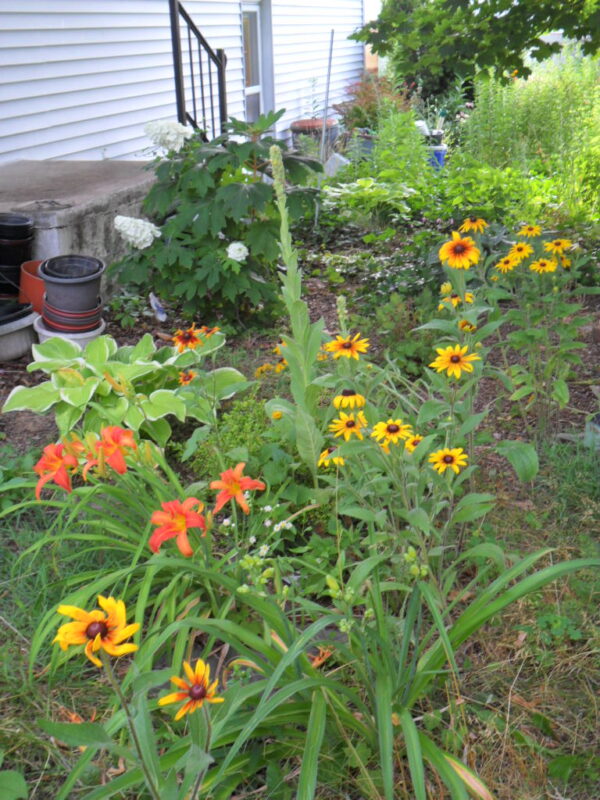
As fire and ice go, summer has a marked preference for the former, at least in this garden. Vibrant yellows, oranges, reds and whites are barely dimmed by burgundy, blue and purple, and cooling comes predominantly from a light breeze in the shade. This year a wet spring has brought forth much – perhaps too much – of the green backdrop, as perennials, natives and outright weeds have had a literal field day filling in the formerly empty spaces between planned plantings. Though we commenced a drought early in the month, much of the season’s bloom was already promised in the bud, and timely irrigation, by bucket or hose, should provide fulfillment in due course.
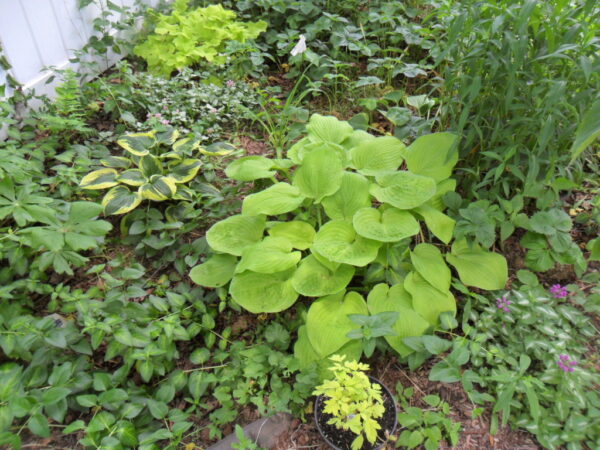
The verdant bonanza has led to a huge bump-up in firefly populations, an unexpected but more than welcome bonus. Where formerly the fallow fields behind the property were their unimpeded range, housing developments which began five years ago have now transformed that fertile biosphere into a hellscape of mowed lawns, hot tubs and kiddie play castles. Driven from their home, refugee fireflies sought protection in my native-focused garden, though conditions at first offered little succor, with much empty space and little of the cover they need for the daylight hours.
But the fireflies held on, gradually increasing their numbers, and this year, with the vast green covering, they have exploded into an exuberant light show. There is nothing quite so magical as watching fireflies rising from the foliage at dusk. First one, then two, then a dozen, then scores, twinkling their green-gold invitations to the dance. Many species of fireflies require this twilight signaling to find mates, and encroaching light pollution from rural development has seriously curtailed their habitats, eroding their populations. But here at least they have their haven, and reward me of a humid summer evening with their entrancing glow.

Though June can be slow off the mark for color, there are exceptions. As if to ease us into the hot tones to come, oakleaf hydrangeas burst into brilliant white blossoms, lighting up the shade like so many beacons heralding the solstice to come.
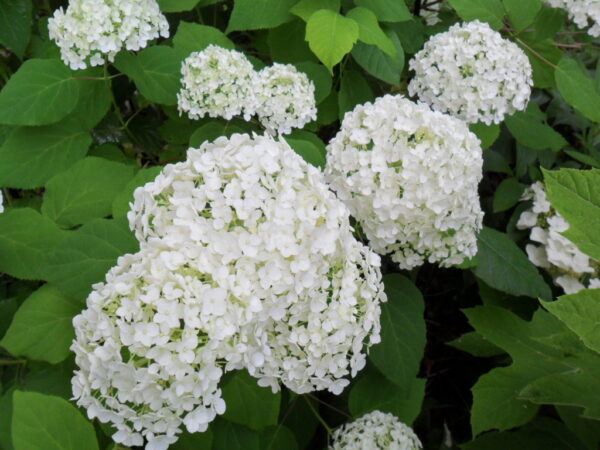
Annabelle, my only arborescens hydrangea, is always the first to bloom, covered in plump pastel green globes that rapidly blanche to purest white as they unfurl. But Annabelle, unfortunately, has a structural problem, an inherent weakness that inclines her to bend groundward when rain drenches her blossoms. After the event, she has a hard time raising herself again, so this year I provided her with some supports, in the form of six garden stakes around her base, linked with heavy-gauge wire amidships. This superstructure disappears as Annabelle awakes from her winter slumber, enrobed by the new greenery, so her “girdle” isn’t apparent. I gave her but one truss this year, which has proved insufficient, though helpful. I’ll add a second row of wire higher on the stakes for next year, and that should accomplish my ends.
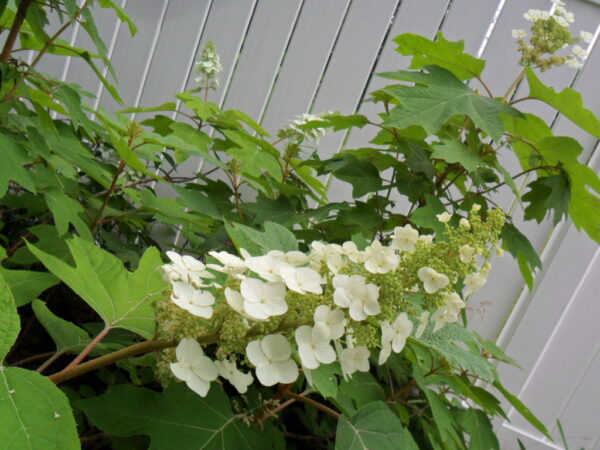
Her near neighbor Alice is being problematic. Again. Refusing to bloom for three years, last summer she finally put out, with a broad range of long, tapering blossoms that emerge white, but gradually blush to pink, then pale magenta. But this year she has been withholding again; there is bloom, but it’s sparse, especially given her huge increase in size, very rapidly approaching her promised 8’ x 8’ state at maturity. I contemplated giving her a trim after she blooms, to encourage side branches, and thus more flowers in future. Hydrangeas only bloom at terminal ends, not mid-stem, so more branching means more blossom, in theory. But as I considered, I really appraised her huge dinner-plate leaves and vast reach, and decided to wait another year before attempting her new coiffure. That’s because Alice, whatever her bloom or lack thereof, gives absolutely stunning fall foliage color, and I didn’t want to deprive myself of the full show come autumn. If she’s niggardly with her bloom again next year, I’ll cut her to the quick!
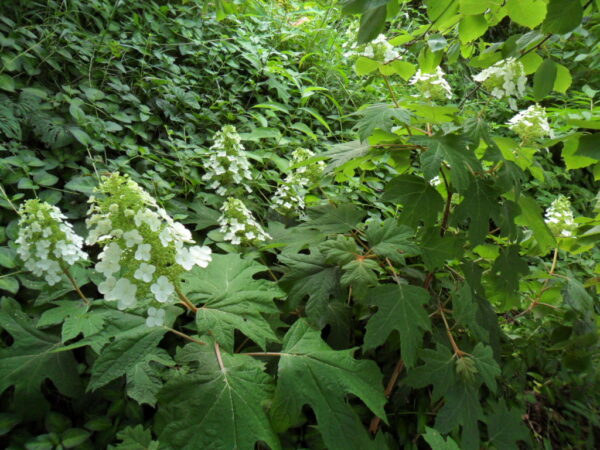
Pee Wee, too, is nearing her full size. As the name implies, she’s a smaller variety of oakleaf, only about 4 feet tall when grown, and perhaps as wide, or a bit wider. Not as showy as Alice, with smaller, less dense flowers, at least she blooms prolifically, though I’m seeing more blossoms to the east, as she searches for the sun from her perch at the periphery of the birch canopy.
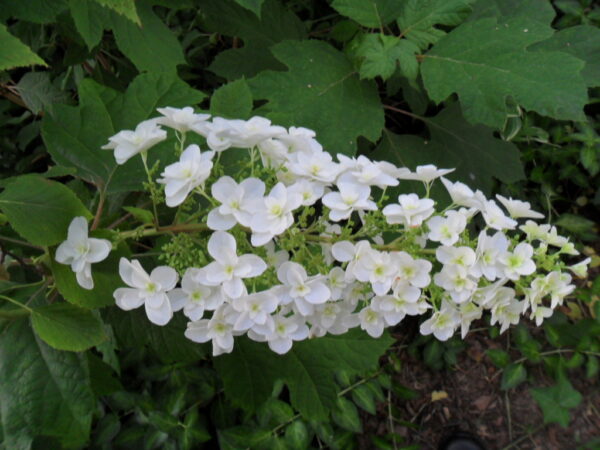
Her near companion is Snowflake, already growing up into the overhanging birch and necessitating a trim of those branches before she becomes irrevocably entangled in them. Snowflake provides the most dramatic flowers of my little group, with blossoms more than a foot long, masses of individual flowerets that are themselves intricately formed, with multiple layers. Snowflake is well-populated this year, and her blooms age to an intriguing blend of pastel mint and rose. She makes an excellent dried flower as well.
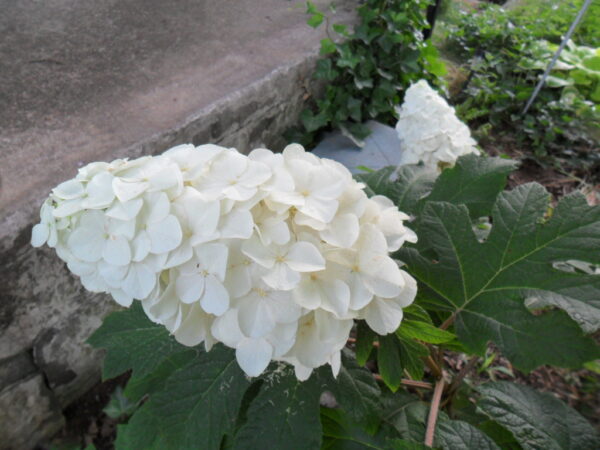
Queen of Hearts is younger than her siblings, the baby of my hydrangea family. Held back further by a wintertime accident her first year, which robbed her of almost half her size, she’s finally come into her own. Four blossoms this year are a 25% increase over last, and I’ll take it. Queenie is the most accessible of my hydrangeas, right outside the kitchen door, and her flowers are unique in my collection. Most oakleafs sport aerial, composite flowers, comprising both showy, sterile sepals and the relatively inconspicuous miniature blooms that are fertile. Typically, both forms are visible on the panicle, with the showier portions emphasized to attract pollinators, but Queen of Hearts’ infertile flowers form a dense, compact shield of pure white which completely covers the fertile portions beneath. As you may guess from her name, Queen of Hearts inclines to pink tones as she ages, but for now, beams brightly, even blindingly.
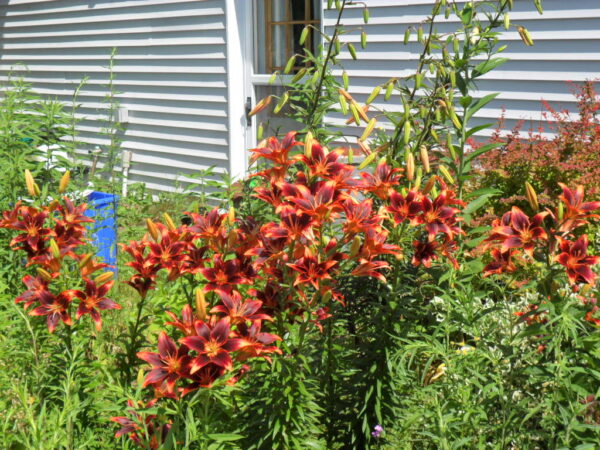
Another standout in the June garden is Asiatic lilies, which typically start for me here early in the month. Unlike my ubiquitous daylilies, their blooms last for extended periods, affording more opportunity to enjoy them. Or they do, if they’re not subjected to a full week of 90+ temps, like these were this year. Yes, their season was considerably truncated, but lovely while it lasted.
Forever Susan always opens first, up to two weeks before her Pink Giant neighbor. Forever Susan is simply stunning – deep red-orange with shafts of purple-black, I call her my “Halloween lily.” The original three bulbs, planted in a triangle, have grown into a healthy cluster now, heavy with bloom. Pink Giant is just behind, and while she was alone at first, she has developed four strong, sturdy stems, from that original solitary stalk. Her flowers are medium pink splashed with maroon freckles, and the bloom head is a good three feet in length, taking weeks to bloom out fully. At over eight feet tall, Pink Giant is aptly named, but she sags routinely, so her height isn’t as noticeable. Every year I say I’ll stake her, and every year I don’t. Maybe 2025 will be the charm.
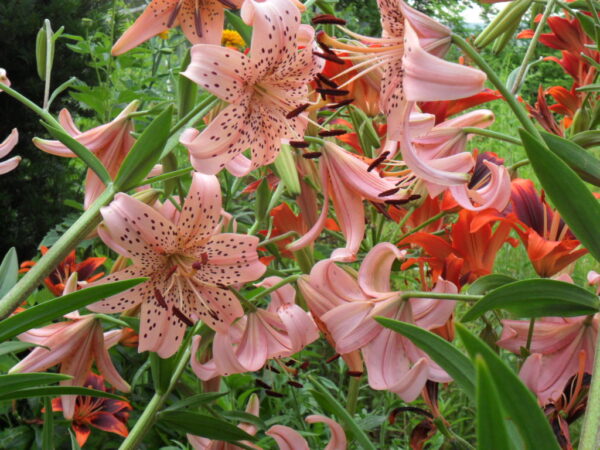
I’d be remiss not to mention some of the other early show-ers, like my yellow Asclepius, AKA “butterfly weed,” and the purple skullcap. Asclepius came to me bareroot four years ago, just as things were starting off here, and I almost lost her that first season. She was slow to adapt, remaining small and spindly, requiring constant hydration, and I was frankly shocked when she returned the following spring. In fact, I’d so given her up for lost that I inadvertently dug up one of the original four, and planted something else in the hole!

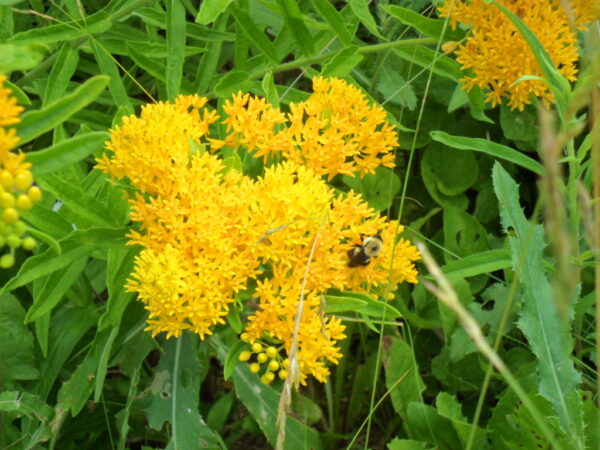
But in that second year, she proved her worth, and though I still need to keep the watering can to hand in periods of drought, over all, she’s been an excellent performer. The huge masses of bright, sunny yellow that greet me now bear no resemblance to her former self, with the plants sprawling over a yard wide, and literally buzzing with pollinators.
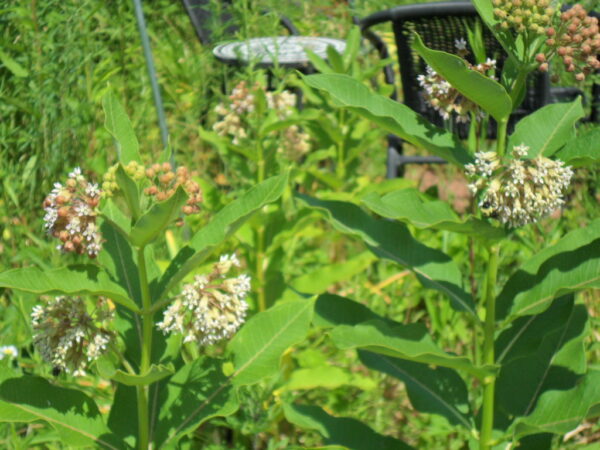
Asclepius is in the milkweed family and I’m told that Monarch butterflies will lay their eggs there, but I’ve seen no sign of it. They do, however, favor the local native milkweed that seeded itself here in the first year and has slowly grown into a reliable colony. Milkweed is the only plant that hosts the Monarch caterpillar, so again, loss of natural habitat like the field formerly behind me has been a crippling factor for this at-risk lepidoptera. It’s a rare thing indeed when a gardener is rooting to find defoliated plants, but I cheer when I see my native milkweeds have been eaten down to the bare stem. It means at least one more Monarch will be winging its way to winter quarters in Mexico.
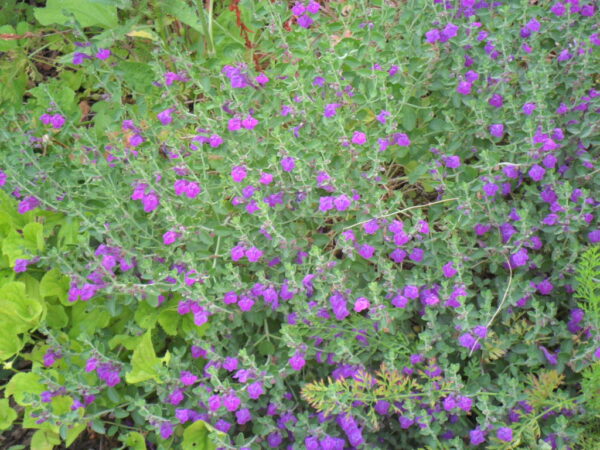
The skullcap was another mail-order purchase, one of a select club of live plants acquired that way, which actually lived. And thrived – it started with a small 3” pot, and now, three years later, it’s a lovely mound about 18” in diameter, peppered with medium purple blossoms. Skullcap is another long-keeper, taking weeks to bloom out, and sometimes favors me with late-season rebloom. I heartily wish I’d bought more at the time, but the grower is now defunct, and I haven’t seen it elsewhere.
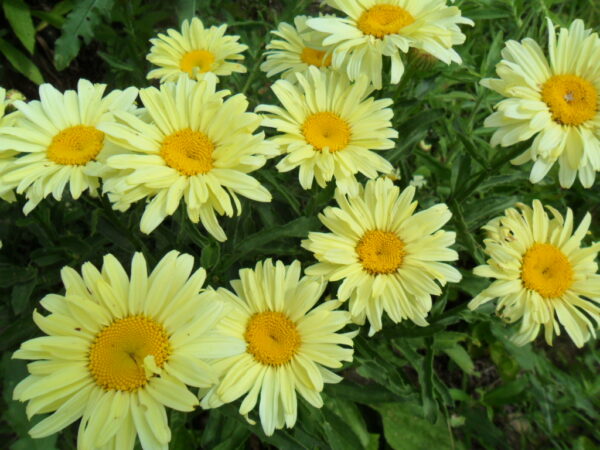


Shasta daisy also brightens June, with its hatch-edged foliage and classic daisy appearance (though it’s actually classed as a leucanthemum). I have two, both marked just “Shasta” when I bought them, but one is markedly more yellow than the other, which tends toward a creamy white resembling buttermilk. The latter is far and away the more vigorous of the two, but the former has a strike against it in residing on the sandmound slope; in dry weather, the heavy thunderstorms dump gallons of rain that simply run off the hill, before they can soak into the parched earth, so that plant is under perpetual hydration stress.
As the month wanes, some of the annual native rudbeckias are up and doing, in their wide array of colors and styles; echinacea has seeded itself far and wide, and is just beginning to open its cone-centered flowers, so popular with goldfinches; and a few daylilies are giving me a sneak preview of their grand opening in July.


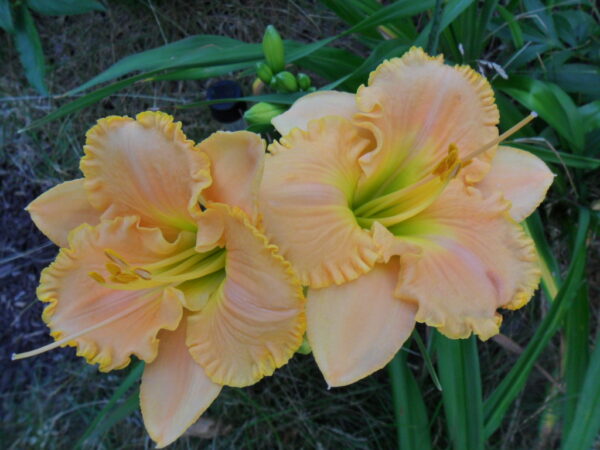
Among these is Chesapeake Crab Legs, one of my all-time favorites, so-named for its uncanny color match to the boiled crustacean so popular in the summer months, and the elongated petals which suggest its legs. With delicate, almost willowy petals borne aloft on slender stems, it can be subject to flopping, but keeping it hydrated as necessary thru the bloom cycle generally results in a good show. It’s always a joy to see this early bloomer, but I wish it would last longer, so folks coming to see the daylilies at their zenith could enjoy it, too. By then, sadly, it’s bloomed out, but I suppose it’s nice to have a secret love all my own.
Vintage Bordeaux is another early-blooming lily named for its tonal resemblance to a foodstuff. This rich red-maroon stunner is a flower to be sipped and savored, like a fine aged wine, a multi-bloomer that often sports several blossoms open simultaneously on the same stem. Funny that we use the term “bouquet” when referring both to flowers and wine; this Vintage Bordeaux has no “nose” to speak of, but it’s just as heady, in its own way.
Every year there’s a different variety that crosses the finish line first, and this year the winner of the Daylily Derby was Collier, a ruffled-edged beauty in caramel with butterscotch highlights, which opened for me on June 1st, earliest ever. As the plant matures, more of this natural play of color reveals itself, and this year the butterscotch was especially notable.
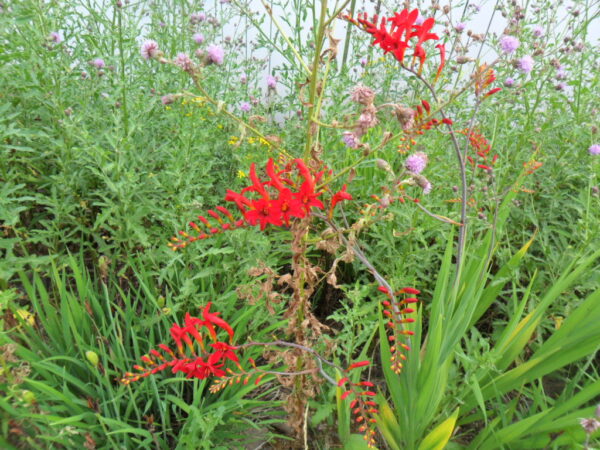
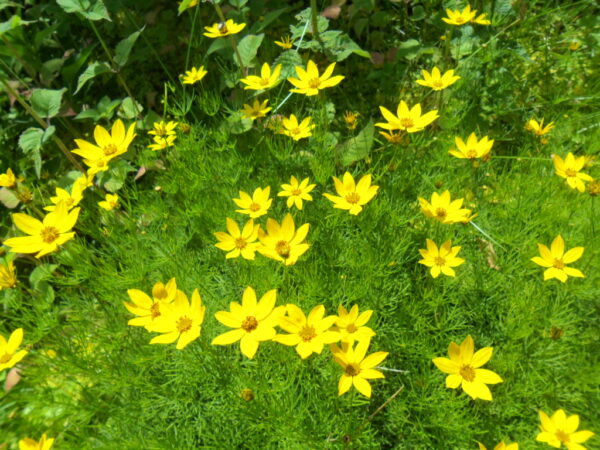
I don’t cut daylilies for indoor use because, unless already well-advanced, the side buds won’t develop and open in water, and that bloom is lost. But it has become my custom to pluck just a single open flower daily, from the mass of buds, and float that in a bud vase. That way I get to focus on a different one of my babies every day, having it close to hand to admire its beauty. The highlight of my morning in July is the walk through the lily beds, just after dawn, snapping off the prior day’s spent buds, and choosing my companion daylily for that day. Not a bad start.

Things are popping inside as well, with summer décor in all its profusion. Summer is one of the slacker seasons for indoor decorating, but the house is still fuller than most you’ll see. The main themes are sunflowers; other summer florals like poppies, brown-eyed Susans, and geraniums; solar images; and of course, patriotic, “stars & stripes”-themed items.
So I’ll leave you with a brief virtual tour of the house in its summer finery; we’re in another dry spell and I really have to get back out to water!





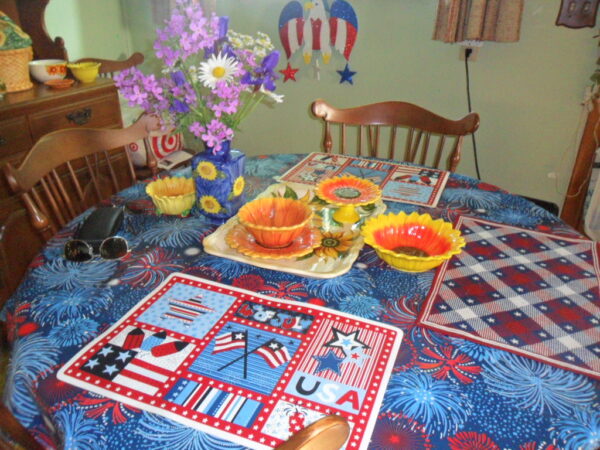
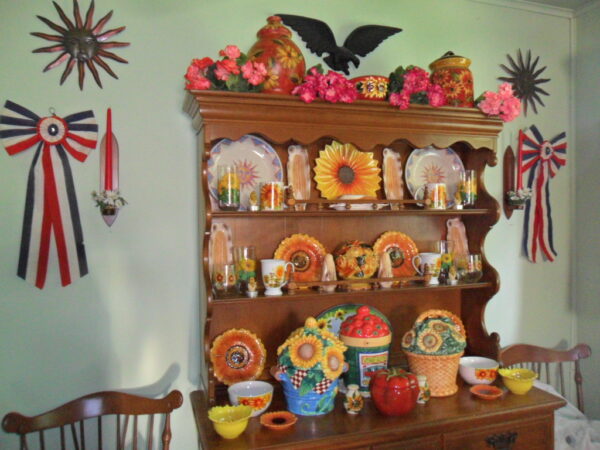
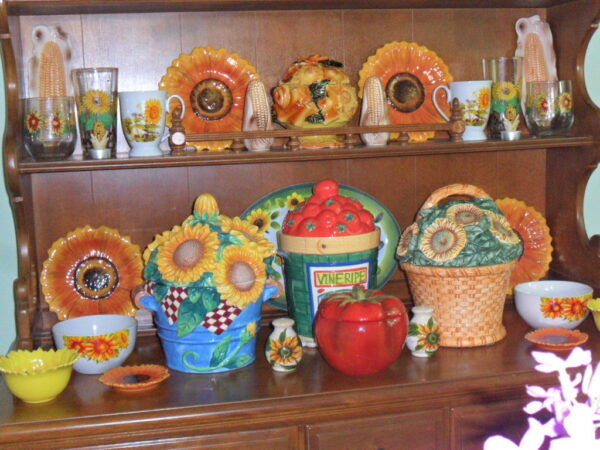
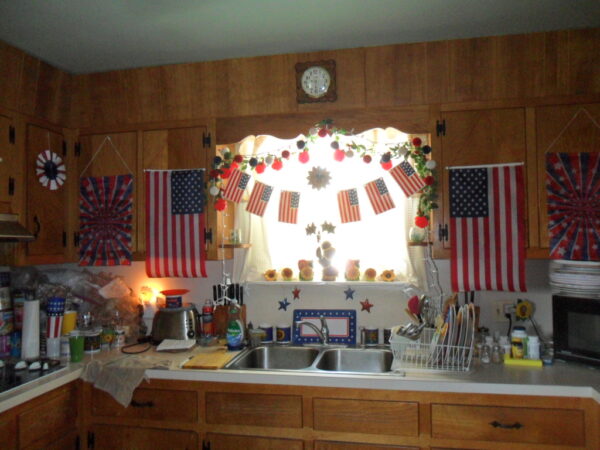
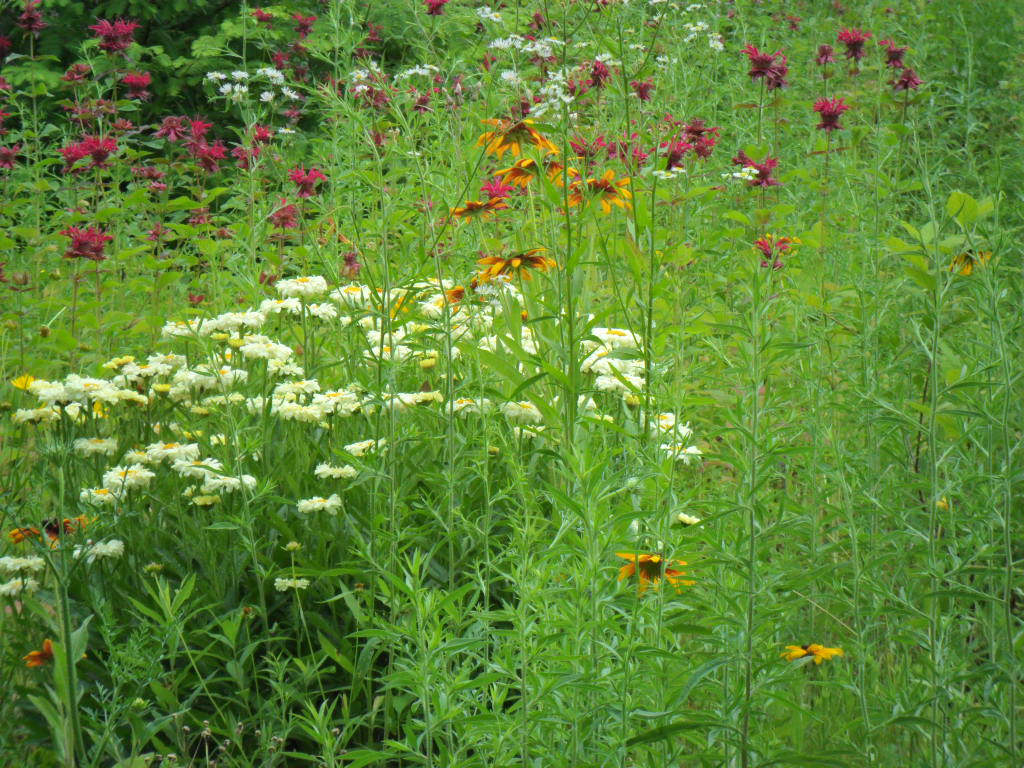

4 comments, add yours.
Irmgard Dering
Food for the soul!
edna
Thank you, once again for sharing your bounty – It’s all so magnificent!
Susan
Love seeing your garden and life through the seasons. Thank you. Would you do a column on the republican convention and Algol. Thanks
Laurien
Beautiful and it’s amazing what you have managed to accomplish in a few short years. Love what you’ve done for the butterflies and fireflies and am especially jealous of the latter which I’ve never seen. Collier’s colour is gorgeous! No one can doubt your patriotism after seeing your decor! Thanks Alex and happy summer!